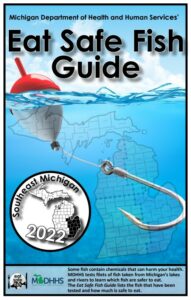
The Do Not Eat Fish advisory that has been in place along the Huron River due to PFAS since 2018 has been relaxed through the lowest stretch of the Huron River in Wayne County from I-275 to Lake Erie. The areas where some fish consumption can be safe includes the popular fishing spots in the Flat Rock impoundment and Huroc Park. This is not a complete lift of the advisory, however, as the Do Not Eat Fish advisory is still in place for the entire Huron River above I-275. The new guidance still makes recommendations for limiting consumption of fish caught below I-275 (see below).
While it’s not a complete lift of the Do Not Eat Fish advisory and many people that rely on fish for sustenance are still adversely affected, the updated guidelines are an encouraging sign that the PFAS levels in fish have fallen after the removal of a major source of PFAS contamination to the Huron River. Removing sources of PFAS to the river, and avoiding contamination from new sources, is the most effective way to keep people and fish safe from PFAS.
The updates are a part of the Michigan Department of Health and Human Services (MDHHS) 2022 Eat Safe Fish Guides. These regional guides help anglers avoid harmful exposure to chemicals that can build up in fish while still informing them how much is safe to eat.
Fish consumption guidelines due to PFOS are still in place for the following species from where I-275 crosses the Huron River to Lake Erie:
- Bluegill and sunfish: A healthy adult should eat no more than eight MI Servings per month due to PFOS.
- Rock bass should not be eaten and are still under a ‘Do Not Eat’ advisory due to PFOS.
Other advisories:
Fish in several lakes through throughout the watershed are contaminated by PFAS or other chemicals, including PCBs and mercury. Before you fish, please refer to the statewide guidelines provided by MDHHS to figure out how you should limit your consumption of various species in certain places.
In the lower Huron River below I-275, the following additional guidelines apply:
- Carp smaller than 28″: Smaller carp can be eaten.
- Carp larger than 28″: Anglers should limit their consumption of larger carp. They should not be eaten by people under the age of 15, those who have health problems like cancer or diabetes, those who may have children in the next several years, those who are pregnant, or those who are breastfeeding. People who are not included in those categories should limit their consumption to 1 to 2 servings of carp from the area each year.
- Catfish: Recommended limit of 1 MI Serving* per month due to PCBs.
- Largemouth and smallmouth bass: Recommended limit of four MI Servings* per month due to PCBs and mercury.
*MI Servings are dependent upon the weight of the person eating fish and other factors and can be found on page 6-7 of the Eat Safe Fish Guide.



